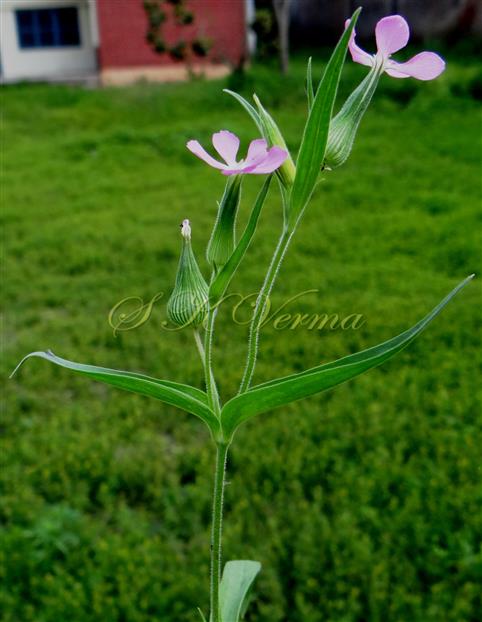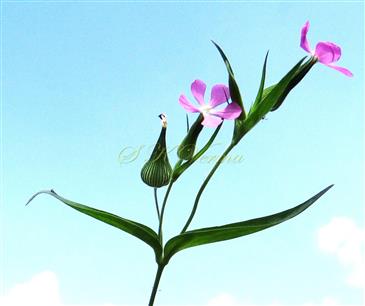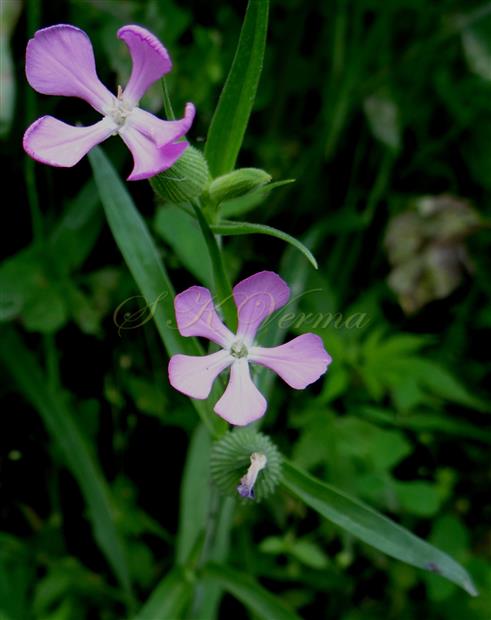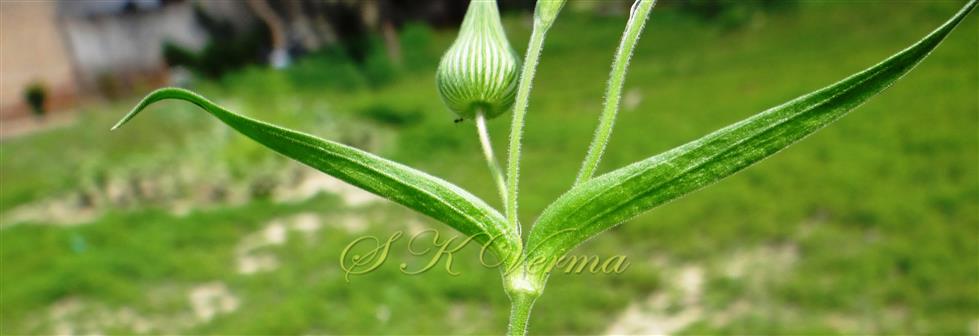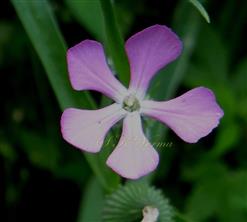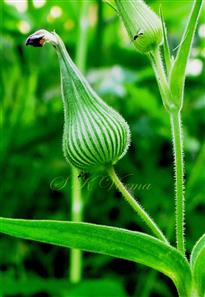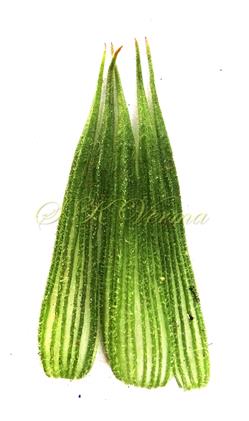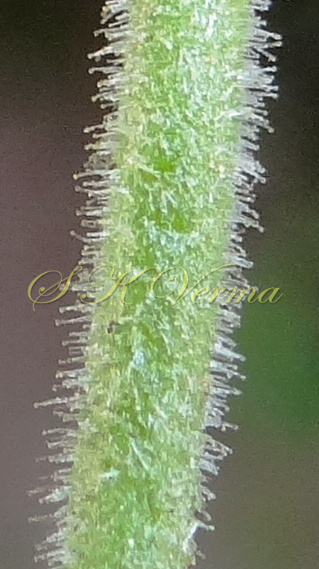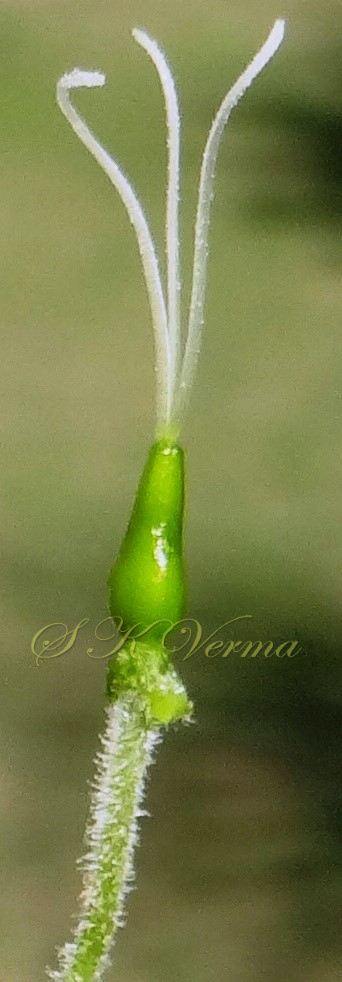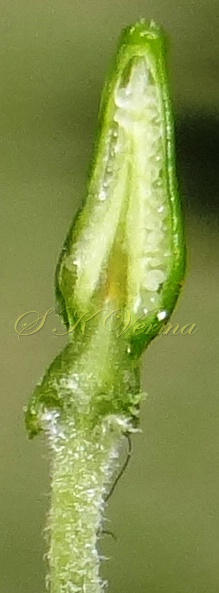SILENE
Silene L., Sp. Pl. 1: 416. 1753; Gen. Pl. ed. 5. 194. 1754; Boiss., Fl. Or. 1: 567. 1867; Collett, Fl. Siml. ed. 2: 46. 1921 (Reprint 1980); Lihua et al., Fl. China @ eFloras. Org 6: 66; Mortan, Fl. North Amer. @ eFloras. org vol. 5: Ghazanfar & Nasir, FL. Pak. @ eFloras. org p. 56.
Annual or perennial herbs, usually viscid. Stems often tufted, erect or ascending or creeping. Leaves radical (basal) and cauline; basal leaves petiolate; cauline leaves usually opposite, occasionally whorled, connate proximally, sessile, blade 1-5-veined, linear or lanceolate to ovate-lanceolate, elliptic, obovate or spathulate, herbaceous. Inflorescences terminal or sometimes axillary, simple or branched, sometimes condensed cymes, frequently flowers few or solitary, frequently glandular-pubescent and viscid. Bracts paired, herbaceous or scarious or absent. Bracteoles absent. Pedicels erect, rarely flowers sessile or subsessile. Flowers actinomorphic, bisexual, rarely unisexual, pentamerous, hypogynous. Calyx tubular, funnelform, campanulate or ovoid, usually narrowed towards mouth, 5-toothed, teeth with ciliate membranous margin, (5-)10-30-nerved. Petals 5, free, each with sometimes auriculate claw; limb entire, bifid, 4-fid or laciniate, variously coloured; coronal scales present. Androgynophore +/- conspicuous. Ovary, stamens and petals borne on a carpophore (anthophore). Stamens 10, in 2 whorls. Ovary usually with 3 or 5 basal septa, 1-locular in upper region, ovules numerous; stigmas 3 or 5, (rarely 4 styles and stigmas). Fruit usually a capsule dehiscing by 6 or 10 (twice the number of styles), rarely 5 teeth. Seeds reniform, minute, +/- tuberculate, sometimes with abaxial processes or a marginal wing.
424 species
Silene conoidea
Silene conoidea L., Sp. Pl. 1: 418. 1753; Boiss., Fl. Or. 1: 580. 1867; Edgew. & Hook. f. in Hook. f., Fl. Brit. Ind. 1: 218. 1875; Aitchinson, J. Linn. Soc. 28: 37. 1880; Collett, Fl. Siml. ed.2. 47. 1921 (Reprint 1980); Sharma & Kachroo, Fl. Jammu (Illustr.) 2: t. 28. 1983; Dhaliwal & Sharma, Fl. Kullu Dist. 157. 1999; Kaur & Sharma, Fl. Sirmaur. 157. 2004; Singh & Sharma, Fl. Chamba Dist. 184. 2006.
Annual herb, up to 60 cm tall. Stem erect, simple or sparsely branched in upper parts, densely glandular-pubescent. Leaves 2.5-10 cm x 0.5-1.2 cm; basal leaves oblong to linear- lanceolate, sparsely to moderately puberulent on both surfaces; cauline leaves opposite, sessile, linear-lanceolate, base clasping at the nodes, glandular-pubescent, margin ciliate, apex acute, veins parallel. Inflorescence dichasial cymes, few to many-flowered, open, bracteate, bracts resembling leaves but smaller. Flowers erect, ca. 3 cm long, 2 cm across, actinomorphic, bisexual, pentamerous, hypogynous. Calyx green, conical, 2-3 cm x 4-6 mm, lower part broadly ovoid, 6.5-10 mm in diameter, umbilicate at base, upper part attenuate, longitudinal veins 25-30, parallel, not anastomosing, lobes 5, lanceolate, narrow, acuminate, margin ciliated narrowly membranous below; inflated in fruit to 3.5 cm. Petals 5, free, 2.5-3.5 cm long, claw nearly equql or shorter than calyx, 2.0- 2.5 cm long, limb 8-12 mm long, obovate to spathulate or entire, pink to reddish; coronal scales white, ovate lanceolate, laciniate, 2-2.5 mm. Stamens 10, in 2 whorls, equalling claws, 1.6-1.7 cm long, slightly exserted, filaments sparsely shortly hairy; anthers ca. 2 mm long, bithecous. Ovary usually with 3 or 5 basal septa, 1-locular in upper region, ovules numerous; styles and stigmas 3, equalling claws, ca. 1.5 cm long. Capsule flask-shaped, 15- 20 mm x 6-8 mm, included in calyx, opening by 6 recurved lanceolate teeth; carpophore to 2 mm. Seeds brown, reniform, 1.2-1.8 mm broad, tuberculate.
Common Names: Cone Campion, Large Sand Catchfly, Cone Catchfly, Weed Campion, Weed Silene; Takla (Hindi)
